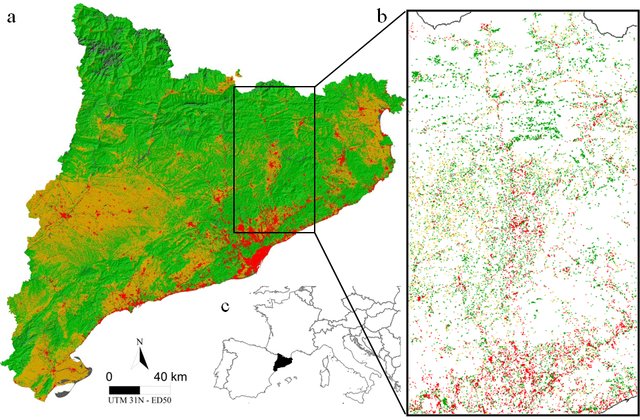New PhD in town: Núria Aquilué, Models and the management of forest landscapes under global changes

Núria Aquilué: MANAGING FOREST LANDSCAPES UNDER GLOBAL CHANGES: SIMULATION MODELS FOR SCENARIO EVALUATION. July 2018.
University: UQAM (Canada). Advisors: Christian Messier, Lluís Brotons, Marie-Josée Fortin
In this thesis, Núria Aquilué presents two simulation modelling approaches to characterise forest ecosystems to then evaluate landscape-scale forest management strategies to be applied in an uncertain global change context. All the proposed strategies seek at enhancing resilience of forest landscapes to shifting disturbances regimes. She applies each of these two modelling approaches to two distinct highly managed forest regions.
More info:
Highly managed forest landscapes are complex socio-ecological systems exposed to multiple drivers of change. Their dynamics emerge from the multi-scale interplays between ecological processes, natural disturbance regimes, anthropic activities, and exogenous factors such as climate. Global changes are expected to interfere on these processes leading to decreases in the resilience of forest landscapes (i.e. the capacity to cope with and adapt to exogenous pressures and disturbances) to various single or compound disturbances. New forest management strategies adapted to these future environmental conditions need to be developed and investigated.
Firstly, I explore the performance of large-scale fuel reduction policies in shaping the fire regime of a European Mediterranean fire-prone landscape using a landscape dynamic meta-model. I developed a spatially explicit land-use/land-cover change model which is then coupled to an existing spatially explicit fire-vegetation dynamics model. This meta-modelling framework was useful to study the variability on fire suppression effectiveness due to agricultural conversion. Agricultural land (a low-load fuel that reduces fire intensity and allows fire brigades get closer to fire fronts) was allocated in the landscape at various annual rates, following a scattered versus an aggregate spatial pattern, and according to three storylines depicting potential fire management policies in the region.
Secondly, I focused on understanding whether improving functional diversity or connectivity of a fragmented agro-forested landscape in south-eastern Canada fosters ecosystem resilience to natural and anthropogenic disturbances. Here, I introduced a multiscale evaluation of forest resilience based on the response of species functional traits and spatial network properties. I tested the approach to investigate if these alternative management strategies prevent decreases in resilience under future scenarios of drought, pest outbreak, and harvesting. In the fire-prone Mediterranean landscape, I uncovered a non-linear relationship between the amount of new agricultural land allocated within the landscape and the fire suppression effectiveness. Fire suppression effectiveness barely increased at low / moderate annual conversion rates to agricultural land, but it sharply did at high annual conversion rates, meaning that land changes to a low-load fuel land-cover need to progressively accumulate before the system becomes more fire resistant. However, further increases on the agricultural conversion rate did not report clear benefits on fire suppression, meaning that the landscape reached its capacity of influencing the fire regime through fire-fighting actions. Moreover, when agricultural land was allocated in few large patches, effectiveness was higher (at the same rate of conversion to agricultural land) and forest core area was better maintained. In the fragmented agro-forested landscape of south-eastern Canada, enrichment of the less functionally rich forest patches by functionally different tree species, rather than targeting either less or the more connected patches, had a larger impact in improving both, diversity and functional connectivity at the landscape scale. Multi functional enrichment of functionally poor patches was even more cost-effective than a strategy based on multispecies plantations (at random or in riparian zones). Moreover, enriching with pest-resistant species was successful in reducing pest-induced mortality. However, planting drought-tolerant species did not do better at preventing drought-induced mortality than the strategy aimed at increasing overall biodiversity of the landscape.
Although there is an increasing number of models to simulate landscape dynamics and approaches to evaluate ecosystem resilience, the methods developed in this thesis to (1) investigate spatially explicit interactions between land-cover changes, fire behaviour, and fire suppression, and (2) evaluate system-level properties related to forest ecosystem resilience to natural and anthropogenic disturbances are innovative in several ways. First, land-use/land-cover changes are modelled as an emergence contagion process, second the landscape dynamic meta-model has a fire suppression module sensitive to fuel loads spatial configuration, and third ecosystem resilience measures are based on species functional response traits and spatial network topology. In addition, in both examples, the landscape management approaches suggested are totally different from what is currently being done, challenging conventional management regimes. In conclusion, this thesis proposes broad and original methodologies to evaluate resilience-based scenarios for forest landscapes facing global changes. Keywords: model coupling; network analysis; disturbances regimes; forest resilience; landscape management.




